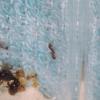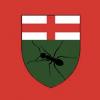- Formiculture.com
- Forums
- Gallery
- Members
- Member Map
- Chat

Long Island, NY. Formica? Lasius?
Started By
LIExotics
, May 30 2022 7:50 PM
6 replies to this topic
#1
 Offline
-
Posted May 30 2022 - 7:50 PM
Offline
-
Posted May 30 2022 - 7:50 PM
Hey everyone. Caught this queen in my back yard today while putting away some stuff. She's 8mm long. She's got beautiful stripes on her gaster, and spines on her legs. I think it's a formica species. But it could be lasius. If anyone could positively identify, that would be greatly appreciated. Thank you in advance.
https://imgur.com/gallery/zeoxfSq
I did a lot of research into both formica and lasius species from NY, then expanded it to the east coast. Then I just looked at all formica and lasius ants. And the problem I'm having is, the ant she most closely resembles is formica fusca. Which according to everything I've read, doesn't live in the United States at all.
She doesn't match any of the lasius queens I looked up, because her body structure, the spines on her legs, and the height of the hump don't match up. So I'm confused. I don't know if I missed a species, or if I overlooked something. So any positive ID would be awesome. Thanks everyone.
https://imgur.com/gallery/zeoxfSq
I did a lot of research into both formica and lasius species from NY, then expanded it to the east coast. Then I just looked at all formica and lasius ants. And the problem I'm having is, the ant she most closely resembles is formica fusca. Which according to everything I've read, doesn't live in the United States at all.
She doesn't match any of the lasius queens I looked up, because her body structure, the spines on her legs, and the height of the hump don't match up. So I'm confused. I don't know if I missed a species, or if I overlooked something. So any positive ID would be awesome. Thanks everyone.
#2
 Offline
-
Posted May 30 2022 - 8:26 PM
Offline
-
Posted May 30 2022 - 8:26 PM
Camponotus nearcticus queen. Her gaster seems quite small (usually a sign of malnourishment) so I would recommend feeding her before leaving her to found a colony.
Edited by Manitobant, May 30 2022 - 8:28 PM.
- LIExotics likes this
My journals:
Polyergus Mexicanus: https://www.formicul...gs/#entry175528
Lasius minutus: https://www.formicul...cs/#entry174811
Lasius latipes: https://www.formicul...gs/#entry206449
General acanthomyops journal: https://www.formicul...yops-with-eggs/
Polyergus Mexicanus: https://www.formicul...gs/#entry175528
Lasius minutus: https://www.formicul...cs/#entry174811
Lasius latipes: https://www.formicul...gs/#entry206449
General acanthomyops journal: https://www.formicul...yops-with-eggs/
#3
 Offline
-
Posted May 30 2022 - 9:31 PM
Offline
-
Posted May 30 2022 - 9:31 PM
Thank you Manitobant. I did some more research on this specific species. Found it really cool this species of ant produces majors and super majors. I gave her a cotton piece dipped in honey water (I use a 4 to 1 ratio - 4 parts water to 1 part honey. I got this from watching other videos. If you have further suggestions on a better method, or a product you prefer better then honey water, feel free to let me know). I'm new to ant keeping. Only been doing it for 6 months so far. Little bit less actually. But I love it. And I'm always looking to learn more. So, if you've raised this species of ant, or have any other suggestions, I'm always looking to learn more. I've been reading up on this species since I saw your comment, and I've gotten a lot of info about them such as their colony size usually doesn't go more then 300 but can go to 500, sometimes they can be polygynos, and they produce majors and super majors. Which is really cool.
#4
 Offline
-
Posted May 31 2022 - 5:06 AM
Offline
-
Posted May 31 2022 - 5:06 AM
This species does not have super majors, as it does not have two distinct castes. In captivity, I have only observed two castes. I founded this species through pleometrosis last year and only two colonies out of the 11 I had kept more than one queen. The maximum number of queens I have seen that are able to found together and retain queens for over a year is two. I do not doubt that the number may be larger in the wild or in more polygynous populations. I would not be surprised if she only laid a few eggs as the queens do not have very many nanitics. They produce majors very quickly as they are mostly arboreal (my two queen colony got two majors in September and a male in October in their first year).
- LIExotics likes this
#5
 Offline
-
Posted May 31 2022 - 7:34 AM
Offline
-
Posted May 31 2022 - 7:34 AM
Thank you. Being that they are arboreal, I am going to experiment with some arboreal set ups and nesting sites.
#6
 Offline
-
Posted May 31 2022 - 8:25 AM
Offline
-
Posted May 31 2022 - 8:25 AM
Just know that even though they are arboreal, you can still keep them well in test tubes. They will just prefer drier areas of the nest.
- LIExotics and FloridaAnts like this
#7
 Offline
-
Posted June 1 2022 - 3:39 PM
Offline
-
Posted June 1 2022 - 3:39 PM
Can you repost the picture? that link is dead.
1 user(s) are reading this topic
0 members, 1 guests, 0 anonymous users
















